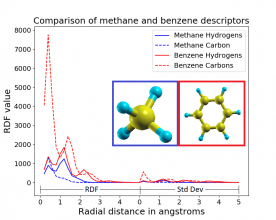Machine learning for material property prediction

Project Information
big-data, data-wrangling, computational-chemistry, molecular-dynamics, machine-learning, python, gpuProject Status: Complete
Project Region: Northeast
Submitted By: Northeast Cyberteam
Project Email: liping.yu@maine.edu
Project Institution: University of Maine Orono
Anchor Institution: NE-University of Maine
Project Address: 105 Bennett Hall
Orono, Maine. 04469
Mentors: Chris Wilson, Larry Whitsel, Bruce Segee
Students: Michael Butler
Project Description
Density Functional Theory based methods for calculating material properties from first principles require large computation facilities and significant computation time. This project aims to develop novel machine learning models and workflows in order to better predict material properties in a fraction of the computation the time that current techniques require.---
Traditionally, the physical properties of solids are calculated from solving the many-body Schrödinger Equation, using atomic compositions as inputs. Such methods are often computationally demanding and the data generated in this way are disconnected from each other. Although massive amounts of physical property data of materials have been accumulated, the calculation of properties for a new compound does not benefit from them.
This CITeam project is aimed at developing machine learning models, software, and workflows that can be used in the development of a material descriptor, which can be used to accurately predict the properties of novel materials. The development of such software is a key first step in high-throughput discovery of novel energy materials.
This research integrates theory, computation, and data mining. The results and machine learning workflows generated under this project will benefit researchers in multiple disciplines such as physics, chemistry, material science, and computational science.
This project will require significant computation time and hardware resources and thus benefit greatly from having access to the Umaine super computer.

Project Information
big-data, data-wrangling, computational-chemistry, molecular-dynamics, machine-learning, python, gpuProject Status: Complete
Project Region: Northeast
Submitted By: Northeast Cyberteam
Project Email: liping.yu@maine.edu
Project Institution: University of Maine Orono
Anchor Institution: NE-University of Maine
Project Address: 105 Bennett Hall
Orono, Maine. 04469
Mentors: Chris Wilson, Larry Whitsel, Bruce Segee
Students: Michael Butler
Project Description
Density Functional Theory based methods for calculating material properties from first principles require large computation facilities and significant computation time. This project aims to develop novel machine learning models and workflows in order to better predict material properties in a fraction of the computation the time that current techniques require.---
Traditionally, the physical properties of solids are calculated from solving the many-body Schrödinger Equation, using atomic compositions as inputs. Such methods are often computationally demanding and the data generated in this way are disconnected from each other. Although massive amounts of physical property data of materials have been accumulated, the calculation of properties for a new compound does not benefit from them.
This CITeam project is aimed at developing machine learning models, software, and workflows that can be used in the development of a material descriptor, which can be used to accurately predict the properties of novel materials. The development of such software is a key first step in high-throughput discovery of novel energy materials.
This research integrates theory, computation, and data mining. The results and machine learning workflows generated under this project will benefit researchers in multiple disciplines such as physics, chemistry, material science, and computational science.
This project will require significant computation time and hardware resources and thus benefit greatly from having access to the Umaine super computer.